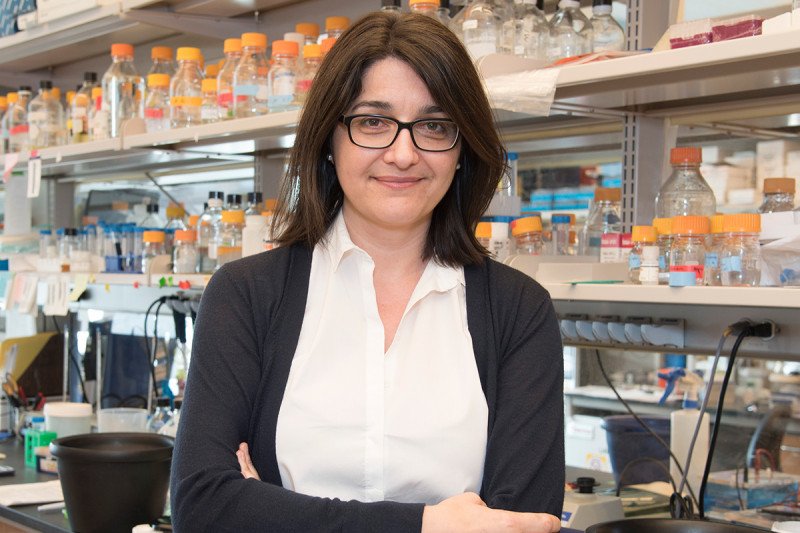
Most people think of cancer as a disease of disorderly DNA. Changes, or mutations, in the sequence of DNA alter the function of the proteins made from that DNA, leading to uncontrolled cell division.
But between DNA and proteins is another layer of information, called messenger RNA (mRNA), which serves as a crucial link between the two. New research suggests that some types of mRNA may carry cancer-causing changes. And, because genetic tests don’t usually look at mRNA, those changes have so far gone undetected by cancer doctors.
“If you sequenced the DNA in cancer cells, you would not see these changes at all,” says Christine Mayr, a molecular biologist at the Sloan Kettering Institute who is the senior author of a new paper on the topic published today in Nature. “But these mRNA changes have the same ultimate effect as known cancer drivers in DNA, so we believe they may play a very important role.”
The findings turn some common assumptions about cancer on their head and point to the need to look past DNA for answers to questions about what causes the disease.
From DNA to mRNA
If DNA is the genetic blueprint for life, as is often said, then it’s a fairly cumbersome set of instructions. The information in DNA is encoded in the particular sequence of some 3 billion nucleotide “letters” — varying combinations of A, T, G, and C. Blocks of these letters — genes — are used to make particular proteins, a cell’s main workhorses. But DNA lives in the nucleus of a cell, while proteins are made in the surrounding cytoplasm. To bridge this gap, a cell must first make an RNA copy of a gene’s DNA. This RNA copy, called messenger RNA, is then transported out of the nucleus. It is this mRNA copy that cells read and translate into a protein.
Usually, the mRNA copy is a bit shorter than its DNA precursor. That’s because the useful pieces of information in DNA, called exons, are often separated by blocks of sequences that are not needed. These unnecessary parts, called introns, must be cut out to make a final product. After the introns are removed, the remaining exons are spliced together, not unlike splicing together pieces of film and leaving some on the cutting room floor.
If the mRNA copy doesn’t include all of the exons in a gene or is cut short, then the protein made from that mRNA will also be truncated. It may no longer function properly. And if that protein is a tumor suppressor — one that protects against cancer — then that could spell problems.
What Dr. Mayr and her colleagues, including postdoctoral fellow Shih-Han (Peggy) Lee, graduate student Irtisha Singh, and SKI computational biologist Christina Leslie, found is that many of the mRNAs in cancer cells produce these truncated tumor-suppressor proteins. The changes occur not only in known tumor-suppressor genes but also in previously unrecognized ones.
“The changes to the mRNA make proteins that are very similar to the proteins that are made when you have a mutation in the DNA that causes a truncated protein to be made,” she says. “In the end, the outcome for the cell is very similar, but how it happened is very different.”
Found: Missing Cancer Mutations
Dr. Mayr’s team looked specifically at chronic lymphocytic leukemia (CLL), a type of blood cancer. A colleague at MSK, Omar Abdel-Wahab, supplied them with blood samples from people with the condition. Using a method that Dr. Mayr’s lab developed to detect these particular mRNA changes, they found that a substantially greater number of people with CLL had an inactivation of a tumor-suppressor gene at the mRNA level than those who had it at the DNA level.
These findings help explain a long-standing conundrum, which is that CLL cells have relatively few known DNA mutations. Some CLL cells lack even known mutations. In effect, the mRNA changes that Dr. Mayr’s team discovered could account for the missing DNA mutations.
Because CLL is such a slow-growing cancer and people with CLL often live for many years, it’s too early to say whether these mRNA changes are associated with a poorer prognosis.
There are some important differences between the mRNA changes and a bona fide DNA mutation. Most important, the inactivation of tumor suppressors through mRNA is usually only partial; only about half of the relevant protein molecules in the tumor cells are truncated. But in many cases this is enough to completely override the function of the normal versions that are present. And because this truncation could apply to 100 different genes at once, the changes can add up.
Lessons for Cancer Diagnostics
Though Dr. Mayr’s team identified the mRNA changes in CLL, they’re likely not limited to this blood cancer. The team found them in samples of T cell acute lymphocytic leukemia too, for example. Other researchers have found them in breast cancer. Dr. Mayr hopes that scientists will be inspired to explore the significance of mRNA changes in these and other types of cancers.
“Current cancer diagnostic efforts predominantly focus on the sequencing of DNA in order to identify mutations,” Dr. Mayr says. “But our research suggests that changes at the mRNA level might be as frequent.”
In other words, cancer diagnostics may need to change to include these previously unknown cancer drivers.





